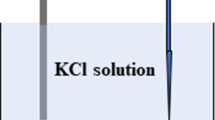Abstract
In pure phospholipid vesicles, the conductivity of H+/OH− ions exceeds that for other simple inorganic ions. Protons achieve electrochemical equilibrium across egg phosphatidylcholine vesicles within tens of minutes. When pH gradients are established across vesicles, transmembrane potentials develop. Conversely, the establishment of transmembrane potentials leads to the formation of pH gradients. When the phenomenological permeability of H+/OH− ions in vesicles is estimated, values are obtained that are much greater (six orders of magnitude larger) than those for Na+ or K+. A wide range in the values for this permeability has been reported; however, much of the discrepancy can be attributed to differences in the vesicle systems and experimental conditions. The H+/OH− current appears to be modulated by changes in membrane dielectric constant. However, the dependence of this current on the pH gradient and on the membrane voltage argues against simple diffusion mechanisms as the source of the H+/OH− current. In addition, in vesicle systems the H+/OH− current shows a surprising invariance to changes in the membrane dipole potential, an observation that argues against the role of simple carriers for H+ and OH− ions.
Similar content being viewed by others
References
Bangham, A. D., Hill, M. W., and Mason, W. T. (1980).Prog. Anesthesiol. 2, 69–77.
Barchfeld, G. L., and Deamer, D. W. (1985).Biochim. Biophys. Acta 819, 161–169.
Cafiso, D. S., and Hubbell, W. L. (1978a).Biochemistry 17, 187–195.
Cafiso, D. S., and Hubbell, W. L. (1987b).Biochemistry 17, 3871–3877.
Cafiso, D. S., and Hubbell, W. L. (1981).Annu. Rev. Biophys. Bioeng. 10, 217–244.
Cafiso, D. S., and Hubbell, W. L. (1983).Biophys. J. 44, 49–57.
Clement, N. R., and Gould, J. M. (1981).Biochemistry 20, 1534–1538.
Deamer, D. W. (1987).J. Bioenerg. Biomembr. 19, 457–479.
Deamer, D. W., and Nichols, J. W. (1983).Proc. Natl. Acad. Sci. USA 80, 165–168.
Dilger, J. P., McLaughlin, S. G. A., McIntosh, T. J., and Simon, S. A. (1979).Science 206, 1196–1198.
Elamrani, K., and Blume, A. (1983).Biochim. Biophys. Acta 727, 22–30.
Flewelling, R. F., and Hubbell, W. L. (1986).Biophys. J. 49, 451–552.
Gutknecht, J. (1984).J. Membr. Biol. 82, 105–112.
Gutknecht, J. (1987).Biochim. Biophys. Acta 898, 97–108.
Gutknecht, J., and Walter, A. (1981).Biochim. Biophys. Acta 641, 183–188.
Hauser, H., Phillips, M. C., and Stubbs, M. (1972)Nature (London)239, 342–344.
Haydon, D. A., and Hladky, S. B. (1972).Q. Rev. Biophys. 5, 187–282.
Huang, C., and Mason, J. T. (1978).Proc. Natl. Acad. Sci. USA 75, 308–310.
Johnson, S. M., and Bangham, A. D. (1969)Biochim. Biophys. Acta 193, 82–91.
Ketterer, B., Neumcke, B., and Läuger, P. (1971).J. Membr. Biol. 5, 225–245.
McLaughlin, S. G. A., and Dilger, J. P. (1980).Physiol. Revs. 60, 825–863.
Montal, M., and Mueller, P. (1972).Proc. Natl. Acad. Sci. USA 69, 3561–3566.
Nagle, J. F. (1987).J. Bioenerg. Biomembr. 19, 413–426.
Nichols, J. W., and Deamer, D. W. (1980).Proc. Natl. Acad. Sci. USA 77, 2038–2042.
Nichols, J. W., Hill, M. W., Bangham, A. D., and Deamer, D. W. (1980).Biochim. Biophys. Acta. 596, 393–403.
Perkins, W. R., and Cafiso, D. S. (1986).Biochemistry 25, 2270–2276.
Perkins, W. R., and Cafiso, D. S. (1987).J. Membr. Biol. 96, 165–173.
Rossignol, M. P., Thomas, P., and Grignon, C. (1982).Biochim. Biophys. Acta. 684, 195–199.
Singleton, W. S., Gray, M. S., Brown, M. L., and White, J. L. (1965).J. Am. Oil Chem. Soc. 42, 53–57.
Szabo, G., Eisenman, G., McLaughlin, S. G. A., and Krasne, S. (1972).Ann. N.Y. Acad. Sci. 195, 273–290.
Toyoshima, Y., and Thompson, T. E. (1975).Biochemistry 14, 1518–1524.
Author information
Authors and Affiliations
Rights and permissions
About this article
Cite this article
Perkins, W.R., Cafiso, D.S. Characterization of H+/OH− currents in phospholipid vesicles. J Bioenerg Biomembr 19, 443–455 (1987). https://doi.org/10.1007/BF00770029
Received:
Revised:
Issue Date:
DOI: https://doi.org/10.1007/BF00770029




